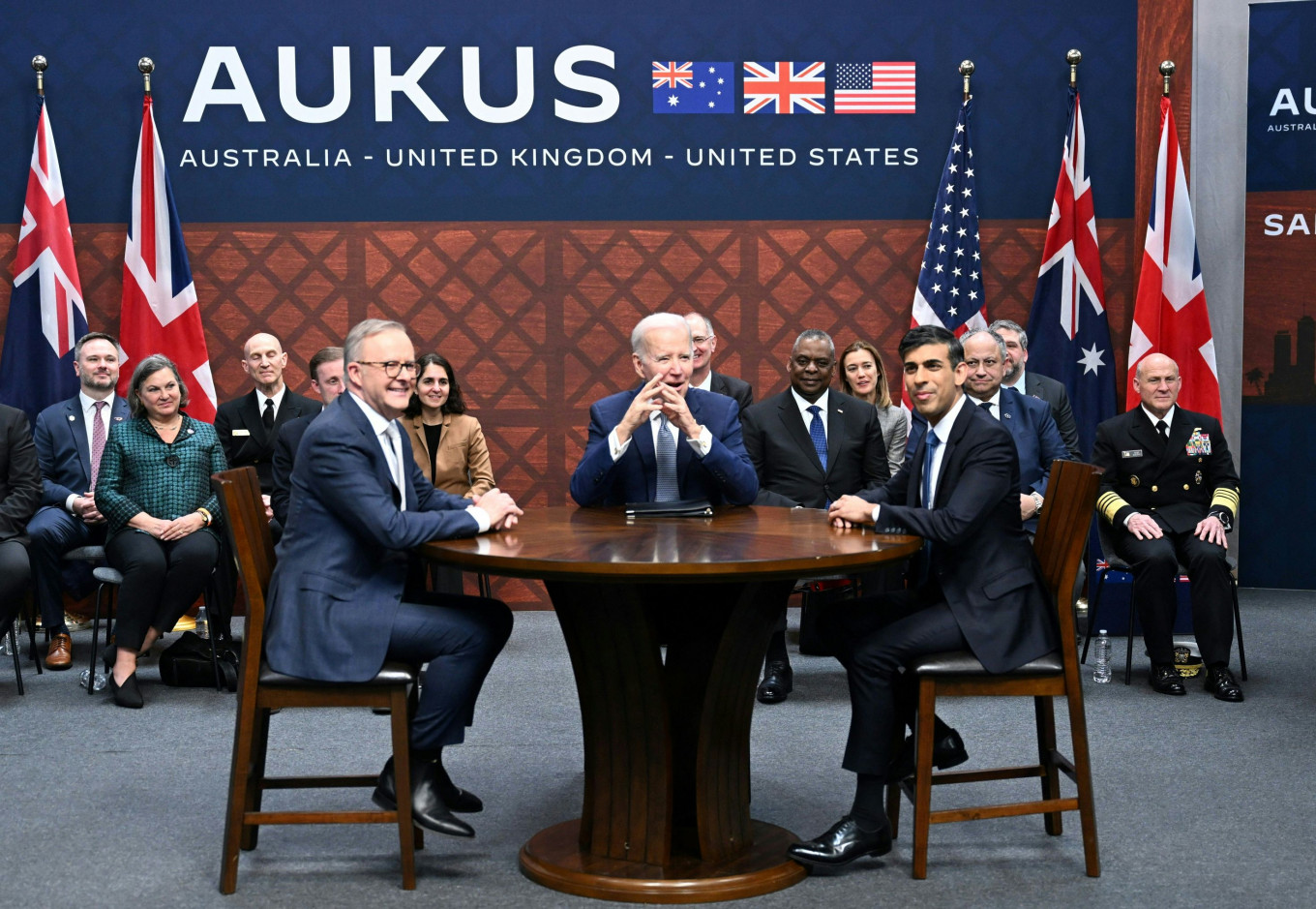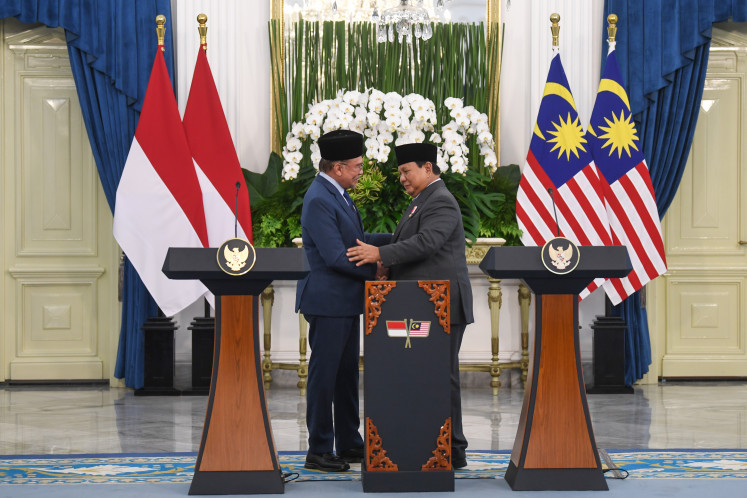Popular Reads
Top Results
Can't find what you're looking for?
View all search resultsPopular Reads
Top Results
Can't find what you're looking for?
View all search resultsHow AUKUS nuclear submarine pact affects Indonesia
The ability for submarines to continue to transit through strategic straits such as the Lombok-Makassar Strait or the Ombai-Wetar Strait, highlights the importance of Jakarta’s control over these waters to be able to defend its sovereign and strategic interests.
Change text size
Gift Premium Articles
to Anyone

T
he publication of the Australian Defense Strategic Review (DSR) on April 24 has led to little to no comments from Southeast Asian countries. In the DSR, Canberra detailed its strategic ambitions for the years to come, after assessing if the country has “the necessary defence capability, posture and preparedness to best defend Australia and its interests”.
Interestingly, the publication of the DSR came a few weeks after the AUKUS military alliance, composed of Australia, the United Kingdom and the United States, announced on March 13 its four-step plan which is aiming to promote security and a “free and open Indo-Pacific region” by enhancing the alliance capacities and minimizing fragmentation effects in the region.
The first phase of the plan will consist of increased submarine port visits and joint training between the US Navy and the Royal Australian Navy (RAN). The second step will rely on the rotational deployment of the US Navy and the UK’s Royal Navy nuclear-powered submarines (SSNs) to Australia, to accelerate personnel training and establish the bases of a sovereign SSN capability. The next phase involves the proposed sale of three US-made Virginia-class SSNs. Finally, in the late 2030s and early 2040s, brand new SSN-AUKUS will be delivered to the Royal Navy and RAN.
Consequently, the recent development of the AUKUS alliance seems to reflect the seriousness of the Australian Defense Force’s (ADF) ambition to operate at the regional level. One might argue that the ADF position fits as part of a broader strategy to deter China’s hegemonic ambitions and aggressiveness in the region.
Yet, it is no secret that Beijing has increased its military presence in the disputed South China Sea and has allegedly deployed its naval assets in the area, along with unmanned underwater vehicles (UUVs), including within Indonesian territorial waters. Thus, Canberra seeks longer-range military, and more particularly naval, capacities such as the acquisition of SSNs to adopt what has been dubbed in the DSR as a global “defensive approach designed to stop an adversary from succeeding in its goal to coerce states through force, or the threatened use of force, to achieve its dominance”.
All in all, the DSR supports the four-step plan detailed on March 13. Indeed, Virginia-class submarines which are expected to be acquired by RAN are versatile boats, engineered to carry out a wide array of missions. Specifically designed for both littoral and deep-water antisubmarine warfare (ASW) operations, such assets could detect and neutralize enemy submarines and surface warships, while also being used as a power projection and deterrence tool thanks to their capacities to handle land targets with cruise missiles or by deploying the Special Operations Force (SOF).
Additionally, like any submarine, it could perform critical intelligence, surveillance and reconnaissance (ISR) operations, provide support to battle groups or surface action groups (SAG) during engagements and participate in mine warfare. Such advanced capabilities and cutting-edge technology make the SSNs crucial assets for enhancing maritime security and advancing the strategic interests of AUKUS in the Indo-Pacific waters.
It seems obvious that the prospect of deploying SSNs near Indonesian borders has prompted close attention from Jakarta’s officials. Back in August 2022, the Indonesian Foreign Ministry presented what has been dubbed the “Indonesian Paper” to the United Nations. The “Indonesian Paper” aimed to raise awareness of the potential risks and championed initiatives for the full implementation of the Treaty on the Non-Proliferation of Nuclear Weapons (NPT), while promoting nuclear technology for peaceful purposes.
However, few headways have been made in the past year. In March of this year, Jakarta’s reaction was more nuanced, as the Foreign Ministry emphasized the importance of maintaining regional peace and stability while refraining from expressing doubts or skepticism over the arms race in the region with the deployment of more SSNs.
It is worth remembering that Indonesia is facing a significant challenge, which has led several local experts to express their concerns. For example, senior politician from the ruling Indonesian Democratic Party of Struggle (PDI-P) Tubagus Hasanuddin, proposed that Jakarta close its Archipelagic Sea Lanes (ASL) as the security pact would likely lead AUKUS members to “engage in nonpeaceful activities”, an argument supported by Gadjah Mada University international relations expert, Muhadi Sugiono. However, it is fair to say that Indonesia’s ability to do this is limited by existing international laws such as the UN Convention on the Law of the Sea (UNCLOS), which authorized foreign submarines and underwater vehicles to navigate submerged within the ASL.
Lastly, the ability for submarines to continue to transit through strategic straits such as the Lombok-Makassar Strait or the Ombai-Wetar Strait, highlights the critical importance of Jakarta’s control over these waters to be able to defend its sovereign and strategic interests and exert its full influence in the regional balance of power.
Consequently, the deployment of the foreign SSNs, including the ones of AUKUS alliance, in Indonesian waters presents a dual impact on Jakarta’s stance on the regional balance of power. While it may help the country overcome the naval modernization gap and the delayed implementation of its Minimum Essential Forces (MEF) target (70 percent by 2024), it could also offer an opportunity to reassess modernization plans and improve interoperability between the three Indonesian Military (TNI) services, while signaling Indonesia strategic value to major powers in the region. In 2020, then TNI chief of general affairs Lt. Gen. Muhammad Herindra emphasized that the latter was also one of the key elements for a stronger underwater defense.
The urgency to build an ideal fleet that can compete with major neighboring powers has increased due to the evolving security context in the region. To improve its maritime surveillance and strike capabilities, the Indonesian government has planned to carefully select submarines that can serve these purposes and provide Indonesia with the needed deterrence capacities.
The procurement of long-range Scorpene-class submarines equipped with antiship missile capacities, supported by the planned acquisition of at least 12 maritime patrol aircraft (MPAs), coastal defense missiles systems, modern warships such as Babcock Arrowhead 140 frigates and new Mince Counter Measures Vessels (MCMV) will significantly enhance Indonesia’s defensive and offensive capabilities on a multidimensional scale.
All in all, having a strong navy with modern assets will support Indonesia to deter potential adversaries while securing its vital and sovereign interests. By having robust, fully operational and flexible naval forces, Jakarta could demonstrate its ability to defend its territorial waters and handle strategic anxieties created by the ongoing military modernization and expansion of its neighbors' forces, while exerting its deterrence as the ongoing tensions between major powers in the Indo-Pacific region would likely to increase in the years to come.
***
Hugo Vojetta is copresident of the Center for Strategic Studies of the Indo-Pacific (CESIP), an independent research center. Andi Raihanah Ashar is the lead analyst for maritime security and counterterrorism at PT Semar Sentinel Indonesia.









